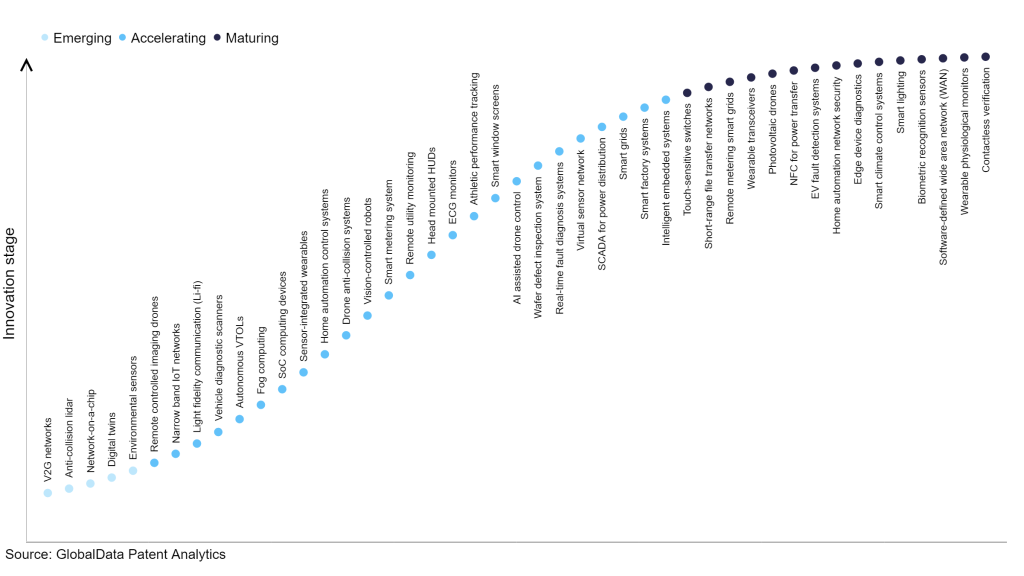The technology industry continues to be a hotbed of innovation, with activity driven by factors such as the proliferation of Internet of Things (IoT) devices, the increasing demand for fast and convenient data exchange, and the rising adoption of smart homes and industrial automation, thereby growing importance of technologies such as Bluetooth, Wi-Fi Direct, Near Field Communication (NFC), and Zigbee. These technologies provide secure and reliable communication channels, allowing IoT devices to establish quick and direct connections for transferring files. In the last three years alone, there have been over 3.6 million patents filed and granted in the technology industry, according to GlobalData’s report on Innovation in Internet of Things: Short-range file transfer networks. Buy the report here.
However, not all innovations are equal and nor do they follow a constant upward trend. Instead, their evolution takes the form of an S-shaped curve that reflects their typical lifecycle from early emergence to accelerating adoption, before finally stabilising and reaching maturity.
Identifying where a particular innovation is on this journey, especially those that are in the emerging and accelerating stages, is essential for understanding their current level of adoption and the likely future trajectory and impact they will have.
300+ innovations will shape the technology industry
According to GlobalData’s Technology Foresights, which plots the S-curve for the technology industry using innovation intensity models built on over 2.5 million patents, there are 300+ innovation areas that will shape the future of the industry.
Within the emerging innovation stage, environmental sensors, digital twins, and network-on-a-chip are disruptive technologies that are in the early stages of application and should be tracked closely. Intelligent embedded systems, smart factory systems, and smart grids are some of the accelerating innovation areas, where adoption has been steadily increasing. Among maturing innovation areas are contactless verification, wearable physiological monitors, and software defined wide area network, which are now well established in the industry.
Innovation S-curve for IoT in the technology industry

Short-range file transfer networks is a key innovation area in IoT
Short-range file transfer networks are designed to facilitate the secure and rapid exchange of files within a limited distance, such as between two computers within a local area network (LAN). These networks are commonly employed when there is a need to transfer sizable files swiftly and safely, especially those containing sensitive information. Ethernet, Wi-Fi, and Bluetooth are prime illustrations of short-range file transfer networks, offering reliable and efficient means of transferring files over a short distance.
GlobalData’s analysis also uncovers the companies at the forefront of each innovation area and assesses the potential reach and impact of their patenting activity across different applications and geographies. According to GlobalData, there are 90+ companies, spanning technology vendors, established technology companies, and up-and-coming start-ups engaged in the development and application of short-range file transfer networks.
Key players in short-range file transfer networks – a disruptive innovation in the technology industry
‘Application diversity’ measures the number of different applications identified for each relevant patent and broadly splits companies into either ‘niche’ or ‘diversified’ innovators.
‘Geographic reach’ refers to the number of different countries each relevant patent is registered in and reflects the
Patent volumes related to short-range file transfer networks
Source: GlobalData Patent Analytics
Samsung Group is one of the leading patent filers in short-range file transfer networks. One of the company's patents focuses on a device that wirelessly communicates with a second terminal through a server. The device includes a communication determiner that decides whether to use a long-range wireless communication mode, which involves communication through the server. Depending on the determination, a communicator sends a connection request to the server and receives a response message containing authentication information. A controller then controls the device to establish wireless communication with the second terminal based on the received response message. Other prominent patent filers in the space include Alphabet and Sony Group.
In terms of geographical reach, ROHM leads the pack, followed by Johnson & Johnson and GoFish Cam. In terms of application diversity, Garmin holds the top position, followed by GoFish Cam and NIKE.
IoT innovation in short-range file transfer networks has revolutionized the way devices communicate and share data in close proximity. This advancement enables seamless and efficient file transfer among IoT devices within a limited range, eliminating the need for complex network setups.
To further understand how IoT is disrupting the technology industry, access GlobalData’s latest thematic research report on Internet of Things – Thematic Research.
Data Insights
From

The gold standard of business intelligence.
Blending expert knowledge with cutting-edge technology, GlobalData’s unrivalled proprietary data will enable you to decode what’s happening in your market. You can make better informed decisions and gain a future-proof advantage over your competitors.







